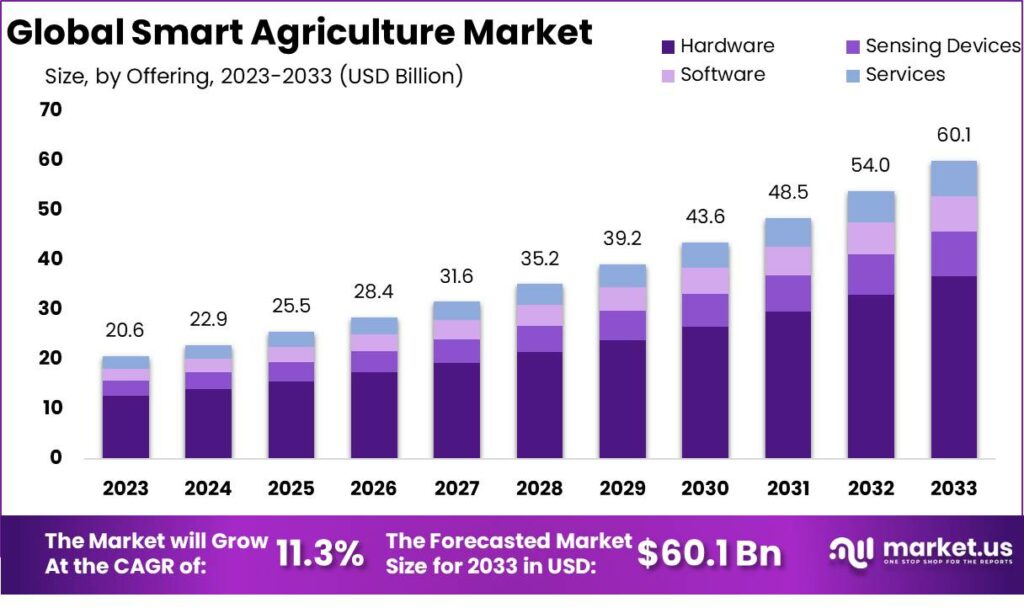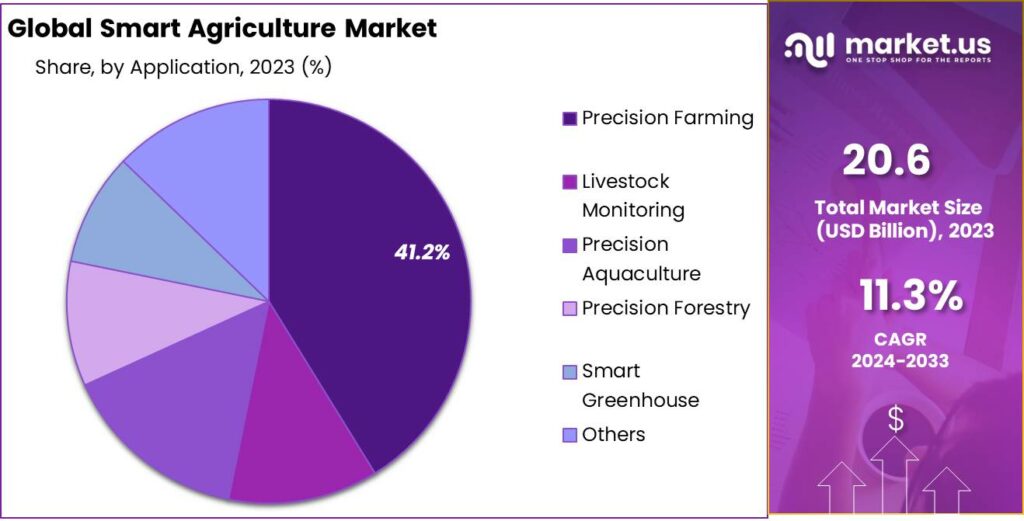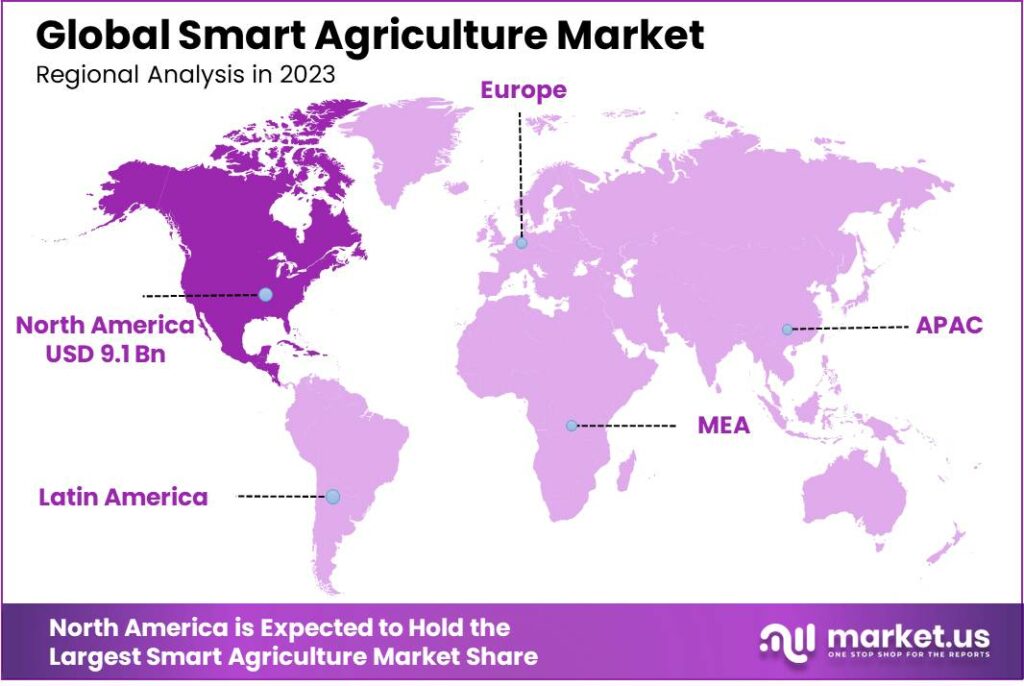New York, Jan. 22, 2024 (GLOBE NEWSWIRE) -- As per the latest analysis by Market.us, the global Smart Agriculture Market value is expected to total USD 20.6 billion in 2023. Overall, Plant-Based Meat demand is projected to increase at 11.3% CAGR throughout the forecast period (2024-2033). Accordingly, the total market valuation is set to reach USD 60.1 billion by 2033.
The smart agriculture market refers to the application of advanced technologies in the field of agriculture, aiming to increase the efficiency, productivity, and sustainability of agricultural practices.
The smart agriculture market is driven by the need to increase agricultural productivity in the face of a growing global population and limited natural resources. It also responds to environmental concerns, aiming to reduce the ecological footprint of farming practices through more efficient use of water, fertilizers, and pesticides. The integration of these technologies into the agricultural sector is a key component of the broader trend towards digital transformation in various industries.

To Understand Geography Trends, Download Sample Report Here: https://market.us/report/smart-agriculture-market/request-sample/
Market Statistics
- Market Outlook: By 2033, the Global Smart Agriculture Market is poised to reach USD 60.1 billion with a steady CAGR of 11.3% from 2023 to 2033.
- Definition of Smart Agriculture: Smart agriculture integrates advanced technologies like sensors, drones, and GPS into farming practices, aiming to enhance efficiency, sustainability, and crop yield.
- Software Landscape: Cloud-based software dominates due to its accessibility, scalability, and effective data management capabilities, driving efficiency in smart agriculture.
- Services Contribution: Data Services lead the segment, offering crucial information on soil quality, weather conditions, and crop health for informed decision-making.
- By Farm Size Analysis: Large farms dominate smart agriculture adoption, leveraging scalability for enhanced efficiency and resource optimization.
- By Application Analysis: Precision Farming leads, driven by technologies like GPS, sensors, and drones, enabling data-driven decisions and reducing waste.
- Regional Analysis: North America leads with over 44% market share, driven by technological advancements and widespread adoption of precision farming.
Find additional highlights on the growth strategies adopted by vendors and their product offerings, Buy Sample Report.
Factors Affecting the Growth of the Smart Agriculture Market
- Technological Advancements: The development and integration of advanced technologies such as IoT, AI, machine learning, and robotics play a crucial role in driving the market forward.
- Increasing Demand for Food: With the global population continuously rising, there is a growing need for enhanced agricultural productivity, which smart agriculture can facilitate.
- Climate Change and Environmental Concerns: The impact of climate change on agriculture has prompted the adoption of smart technologies for efficient resource management and sustainable practices.
- Government Initiatives and Support: Various governments are promoting smart agriculture through subsidies, grants, and supportive policies, thereby accelerating its adoption.
- High Initial Investment Costs: The significant initial investment required for smart agriculture technology can be a barrier, affecting its adoption rate, especially in developing countries.
- Lack of Technical Expertise: A shortage of skilled professionals in IoT, data analytics, and other related technologies can hinder the growth of smart agriculture.
Report Segmentation of Smart Agriculture Market
Hardware Analysis
In 2023, the Smart Agriculture market was defined by a diverse range of hardware components essential for modern farming. The Sensors & Control Systems segment led the market, vital for precision agriculture and data-driven farm management. These sensors, including soil moisture, weather, and crop health sensors, combined with advanced control systems, significantly enhanced resource utilization, crop yield, and minimized waste. The integration of IoT technologies and advancements in AI and machine learning further fueled the expansion of this segment.
HVAC systems also played a crucial role in Smart Agriculture, particularly in controlled environment agriculture, by maintaining optimal temperature and humidity levels for year-round crop growth. The increasing adoption of indoor farming techniques has boosted the demand for HVAC systems, attributed to their efficiency in water usage and protection against variable weather.
LED grow lights saw substantial demand due to their energy efficiency and ability to provide tailored light spectra, which supports increased yields and faster crop cycles. Their role in sustainable agriculture is becoming increasingly significant, with benefits like longevity and reduced energy consumption compared to traditional lighting.
Sensing Devices Analysis
In 2023, the Smart Agriculture market was notably segmented in the area of Sensing Devices, with Soil Sensors emerging as the market leader. These sensors, providing real-time data on soil moisture, temperature, and nutrient levels, became indispensable for precise irrigation, fertilization, and optimal crop growth conditions. Their significant impact on improving crop yields and conserving resources led to their dominant market share.
Additionally, Water Sensors gained importance for monitoring water quality and usage, aligning with the increasing focus on sustainable irrigation practices amidst rising water scarcity. Climate Sensors, which track temperature, humidity, and weather conditions, also held a significant market position. Their role in enabling farmers to adapt to changing environmental conditions and mitigate the impacts of climate change further underscored their importance in the Smart Agriculture sector in 2023.
Software Analysis
In 2023, cloud-based solutions dominated the Smart Agriculture market, owing to their ability to provide unparalleled accessibility, scalability, and real-time data management. These platforms, highly favored for their capability to store, collect, and analyze extensive data from various sources like sensors and IoT devices, empowered farmers with actionable insights for crop management, resource allocation, and yield optimization.
This data-driven approach has positioned cloud-based systems for continued growth, enhancing efficiency, sustainability, and productivity in agricultural practices. On the other hand, web-based platforms, requiring more localized data processing and lacking real-time functionality, served as an alternative for farmers in areas with limited internet access or inadequate cloud infrastructure, offering cost-effective and user-friendly management tools.
Services Analysis
In 2023, the Smart Agriculture market experienced a transformative shift with various service segments playing crucial roles. Leading the way, Data Services, pivotal for data-driven farming, focused on collecting, analyzing, and distributing vital information on soil, weather, and crop health, aiding farmers in making informed decisions for improved yields and resource management. The rise of IoT devices and sensors further propelled this segment. Analytics Services also gained significance, utilizing advanced tools and algorithms, including AI and machine learning, for predictive insights, optimizing farming operations.
Farm Operation Services streamlined daily tasks through digital solutions, enhancing efficiency and reducing costs. Supply Chain Management Services became essential in managing the movement of produce from farm to market, integrating inventory and logistics management. Climate Information Services provided vital weather data, crucial in an era of climate variability. System Integration & Consulting services guided farmers in technology adoption, while Maintenance & Support ensured uninterrupted operation of smart agriculture systems. Managed Services offered comprehensive solutions like remote monitoring, rounding off the suite of services revolutionizing smart agriculture in 2023.
By Farm Size Analysis
In 2023, the Smart Agriculture market demonstrated varying adoption levels across different farm sizes, with large farms leading due to the scalability of advanced agricultural solutions. These large-scale operations extensively utilized technology to enhance production efficiency and operational management. Medium-sized farms also embraced smart agriculture, finding value in cost-effective technologies that improved crop management.
However, small farms lagged slightly in market share, primarily due to budgetary limitations and scalability challenges. Despite these differences, each segment—large, medium, and small—showed potential for growth and innovation, collectively driving the progress of smart agriculture in the industry.
By Application Analysis
In 2023, the Precision Farming segment led the Smart Agriculture market with over 41% market share, driven by its ability to increase crop yields and resource efficiency through advanced technologies like GPS, sensors, and drones. This approach enables farmers to make informed, data-driven decisions, thereby minimizing waste and environmental impact. Livestock Monitoring also gained prominence, utilizing IoT devices for animal health and behavior tracking, crucial for animal welfare and productivity.
Precision Aquaculture saw growth, with technology advancements aiding in controlling water quality and feeding, meeting the rising demand for sustainable seafood. Precision Forestry emerged as a vital segment, optimizing tree harvesting and forest resource management, addressing concerns for sustainable forestry. Smart Greenhouses, facilitating controlled environment agriculture, became popular for offering year-round cultivation and reduced resource use, aligning with sustainable food production goals.

For a better understanding, refer to this sample report, which includes corresponding tables and figures@ https://market.us/report/smart-agriculture-market/request-sample/
Key Market Segments
Hardware
- HVAC system
- LED grow lights
- Valves & pumps
- Sensors & control systems
- Others
Sensing Devices
- Soil sensor
- Water sensors
- Climate sensors
- Others
Software
- Web-based
- Cloud-based
Services
- Data services
- Analytics services
- Farm operation services
- Supply chain management services
- Climate information services
- System integration & consulting
- Maintenance & support
- Managed services
- Others
By Farm Size
- Small
- Medium
- Large
By Application
- Precision farming application
- Yield monitoring
- On-farm
- Off-farm
- Field mapping
- Crop scouting
- Weather tracking & forecasting
- Others
- Livestock monitoring application
- Milk harvesting
- Breeding management
- Feeding management
- Others
- Smart greenhouse application
- Water & fertilizer management
- HVAC management
- Others
- Precision Aquaculture
- Precision Forestry
- Others
Driving Factors
The growth of the Precision Farming market is largely fueled by advancements in smart agriculture technologies, which provide farmers with real-time information on climate, soil health, and crop conditions, leading to increased yields and resource efficiency. This comes at a crucial time when the rising global food demand, due to the steadily increasing world population, calls for enhanced agricultural productivity and sustainable methods.
Additionally, government support through subsidies, incentives, and policy initiatives is playing a significant role in encouraging farmers to adopt smart farming practices. Moreover, environmental concerns are being addressed by smart agriculture's ability to reduce pesticide and fertilizer usage, implement precise irrigation, and lower greenhouse gas emissions, making it a key player in promoting environmental sustainability in the agricultural sector.
Restraining Factors
The adoption of smart agriculture technologies faces significant challenges, including the high initial costs of sensors, drones, and data analytics systems, which can be prohibitive for small-scale farmers and those in developing regions. Additionally, concerns around data privacy and security are paramount, as the collection and sharing of sensitive agricultural data necessitate robust protection against breaches and misuse.
Another major hurdle is limited connectivity in rural areas, where access to high-speed internet and reliable connectivity is often lacking, impeding the effective deployment of smart agriculture technologies. Furthermore, the successful implementation of these technologies requires farmers and agricultural workers to develop new technical skills, presenting a steep learning curve that necessitates comprehensive education and training.
Growth Opportunities
The growth potential of smart agriculture is substantially amplified by the integration of Internet of Things (IoT) technologies, enabling real-time monitoring of crop conditions, equipment performance, and weather, thus facilitating more precise agricultural decision-making. Additionally, the application of blockchain technology in the agricultural supply chain promises enhanced transparency and consumer trust, extending the value of smart agriculture beyond production.
Collaborative efforts with AgriTech startups, known for their innovative and niche solutions, are pivotal in driving market growth. Moreover, the scope for global expansion is vast, especially in emerging markets that are actively seeking to modernize agricultural practices and bolster food security, presenting substantial opportunities for the adoption of smart agriculture technologies worldwide.
Buy Now this Premium Report to Grow your Business: https://market.us/purchase-report/?report_id=16886
Competitive Landscape
The competitive landscape of the market has also been examined in this report. Some of the major players include:
- Autonomous Solutions, Inc.
- GEA Group Aktiengesellschaft
- CropMetrics LLC
- Ag Leader Technology
- BouMatic Robotic B.V.
- Raven Industries
- Argus Control Systems Ltd
- Grownetics, Inc.
- DeLaval Inc
- DICKEY-john
- AgJunction, Inc.
- Farmers Edge Inc
- Gamaya
- Deere & Company
- CropZilla
- Topcon Positioning Systems
- DroneDeploy
- Granular, Inc.
- Trimble Inc.
- CLAAS KGaA mbH
Scope of the Report
| Report Attributes | Details |
| Market Value (2023) | US$ 20.6 Billion |
| Forecast Revenue 2033 | US$ 60.1 billion |
| CAGR (2024 to 2033) | 11.3% |
| North America Revenue Share | 44% |
| Base Year | 2023 |
| Historic Period | 2018 to 2022 |
| Forecast Year | 2024 to 2033 |
Regional Analysis
In 2023, the smart agriculture market saw North America leading with over 44% share, driven by technological advancements, widespread adoption of precision farming, and major industry players, particularly in the United States and Canada. Europe maintained a competitive position, propelled by a focus on sustainable agriculture and stringent food safety regulations, with countries like Germany and France at the forefront of technological integration.
The Asia-Pacific region emerged as a significant market, spurred by rapid urbanization, population growth, and governmental initiatives to modernize agriculture, especially in China and India. Latin America, particularly Brazil, made its mark by embracing sustainable farming and precision agriculture, leveraging its vast agricultural landscapes. The Middle East and Africa, though holding a smaller market share, exhibited potential for growth, driven by the need for smart irrigation systems and efficient resource management in response to water scarcity challenges, indicating a rising interest in enhancing agricultural productivity and sustainability in these regions.

By Geography
- North America
- The US
- Canada
- Europe
- Germany
- France
- The UK
- Spain
- Italy
- Russia
- Netherland
- Rest of Europe
- APAC
- China
- Japan
- South Korea
- India
- Australia
- New Zealand
- Singapore
- Thailand
- Vietnam
- Rest of APAC
- Latin America
- Brazil
- Mexico
- Rest of Latin America
- Middle East & Africa
- South Africa
- Saudi Arabia
- UAE
- Rest of MEA
Recent Developments
- In October 2022, Trimble Inc. launched new displays, GFX-1060 and 1260 to be used in precision agriculture applications. Farmers can complete tasks in the field quickly and efficiently by using these new displays that allow them to track and monitor field data in real-time precisely.
- In September 2022, Deere & Company launched three self-propelled harvesters for forage to complement its existing line-up. They are designed to meet the needs of livestock and dairy producers as well as contractors and harvesters to tackle issues like shorter harvesting times as well as a lower workforce of skilled workers and rising operating costs.
Browse More Related Reports
- Seed Treatment Market is anticipated to be USD 15.5 billion by 2033. It is estimated to record a steady CAGR of 8.4% in the Forecast period 2023 to 2033. It is likely to total USD 6.9 billion in 2023.
- Non-Alcoholic Beverages Market is anticipated to be USD 2,135 billion by 2033. It is estimated to record a steady CAGR of 6.1% in the Forecast period 2023 to 2033. It is likely to total USD 1,349 billion in 2023.
- Edible Insects Market is anticipated to be USD 15.3 billion by 2032. It is estimated to record a steady CAGR of 18.1% in the Forecast period 2022 to 2032. It is likely to total USD 3.4 billion in 2023.
- Microirrigation systems market size is expected to be worth around USD 32.2 billion by 2033, from USD 12.0 billion in 2023, growing at a CAGR of 10.5% during the forecast period from 2023 to 2033.
- Spirulina Market size was valued at USD 511.4 Million and is expected to reach USD 1,338.4 Million in 2032 Between 2023 and 2032, this market is estimated to register a CAGR of 10.1%.
- Aerogel Market size accounted for USD 876.5 million. This market is estimated to reach USD 2600.4 million at a CAGR of 11.8% between 2023 and 2032.
- 3D Printing Metal market size is expected to be worth around USD 20.0 billion by 2033, from USD 2.4 billion in 2023, growing at a CAGR of 23.6% during the forecast period from 2023 to 2033.
- Optical Coatings Market size is expected to be worth around USD 28.0 billion by 2033, from USD 12.6 billion in 2023, growing at a CAGR of 8.3% during the forecast period from 2023 to 2033.
- Synthetic leather market size is expected to be worth around USD 64.6 billion by 2032 from USD 32.8 billion in 2022, growing at a CAGR of 7.2% during the forecast period from 2023 to 2032.
- Flame Retardant Market size was valued at USD 7.6 Billion in 2022 and is expected to reach USD 13.7 billion in 2032 growing at a CAGR of 6.3% during the forecast period of 2023-2032.
About Us
Market.US (Powered by Prudour Pvt Ltd) specializes in in-depth market research and analysis and has been proving its mettle as a consulting and customized market research company, apart from being a much sought-after syndicated market research report-providing firm. Market.US provides customization to suit any specific or unique requirement and tailor-makes reports as per request. We go beyond boundaries to take analytics, analysis, study, and outlook to newer heights and broader horizons.
Follow Us On LinkedIn Facebook Twitter
Our Blog:
